Reviewer's Note: The 2xAA battery tube and replacement tailcap switch with clip for the LF3XT were provided for review by CPF dealer LED Cool. Please see his Dealer's thread in CPFMP for more info.
Warning: Pic heavy!
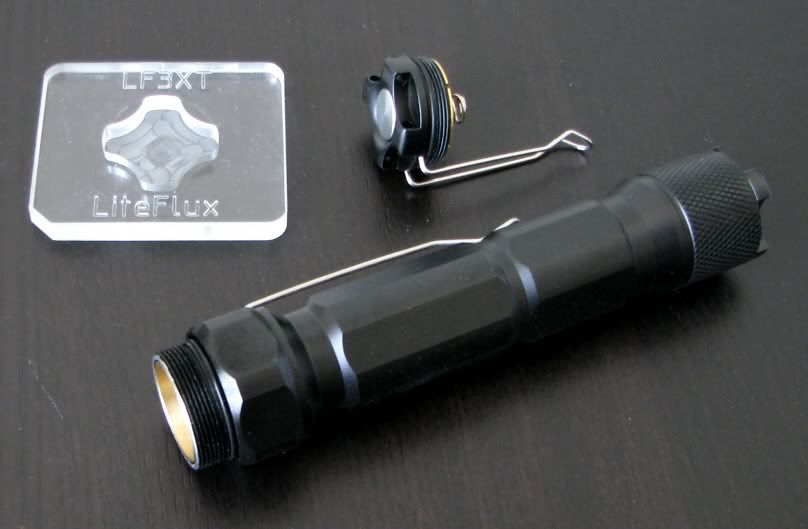
Original LF3XT Manufacturer's Specifications
Please see my original LF3XT review for a thorough background on this light.
New Tailcap with Built-in Clip

The new tailcap is designed with space to include a pocket clip (under a lip near the opening). This makes it ~1.5mm taller than the original tailcap. It also features rounded vertical edges on the cross-headed retaining ring, and a hole in each of the four corners (the original tailcap had only a single hole). The hole can be used to attach a clip-ring, or to help with unscrewing by inserting a suitably stiff rod of proper dimension and twisting the ring counter-clockwise.
To facilitate exchange of the tailcap, the replacement version also comes with an acrylic base that perfectly fits the cross-headed ring, allowing easy unscrewing.
Here's what the original LF3XT looks like when you get it open:
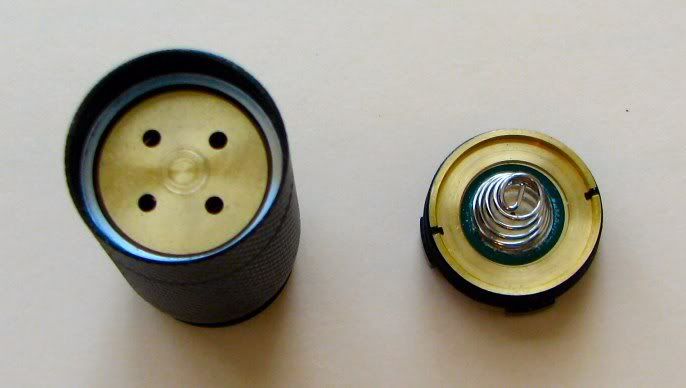
When I first tried to install this new tailcap/clip on one of my LF3XTs, I encountered a slight problem - the pressure of the body on the end of the clip was slightly forcing the end of the clip ring out of the tailcap while tightening. The best I could get it was as follows:
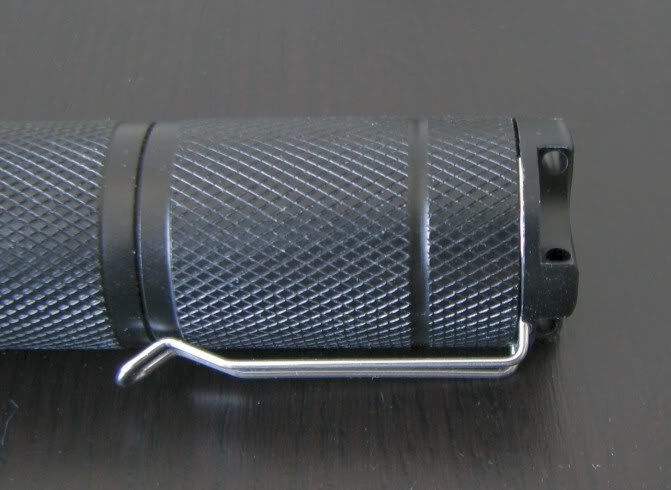
As you can see, the clip ring is preventing the tailcap from fully screwing down. The light cannot function this way, as it is preventing contact between the tailcap and the battery tube.
I found I needed to slightly bend out the clip to prevent this from occurring during tightening:
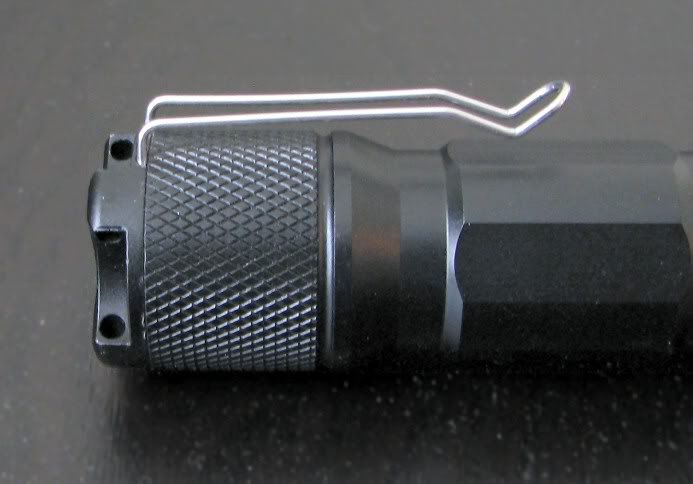
As you can see, I've bent the clip more than was necessary to get it on (shown using the 2AA body above). I advise caution when playing with the tolerances here - try installing the clip as shipped. If you have any problems, apply no more than a slight pressure to bending out the clip. You don't want to do any more than is necessary to get it on.
FYI, even once I had resolved the clip issue, I still had difficulty tightening the new button/clip sufficiently to allow activation on my LF3XT body. Even with the tailcap tool, I found I needed to use vicegrips on the body to fully tighten (with a cloth to prevent marring the finish, of course) . It was much easier to tighten the new tailcap onto the 2AA body (could be done by hand easily with the tool), so it's possible there is some variance involved with first batch LF3XTs. :shrug:
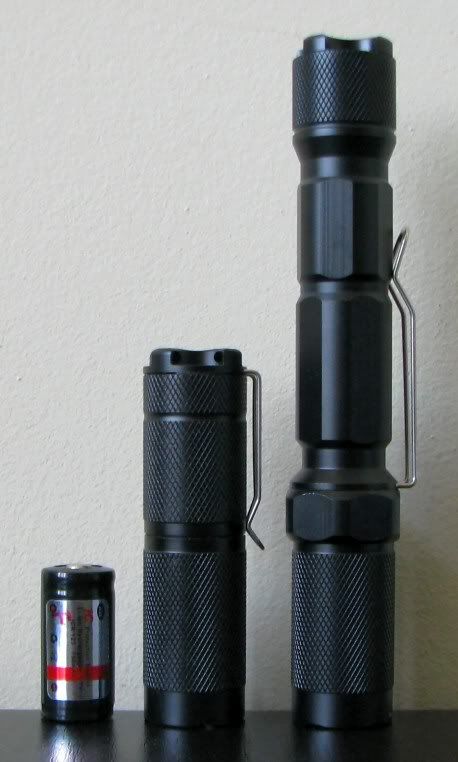
(from left to right: AW protected RCR, LF3XT with new clip tailcap, LF3XT with 2xAA battery tube and tailcap)
2xAA Battery Tube
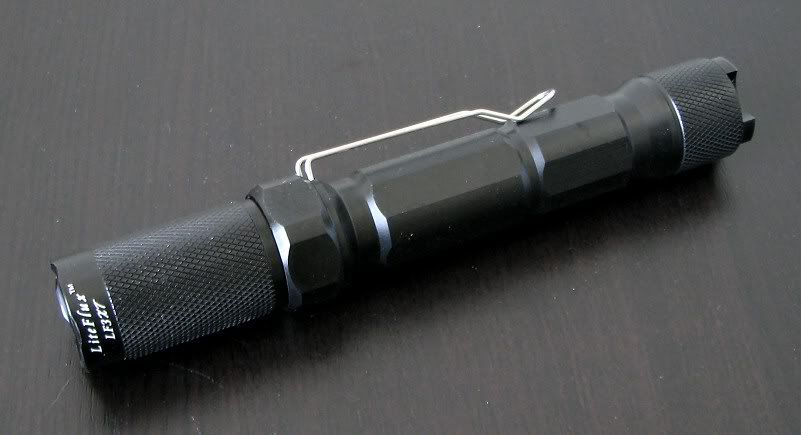
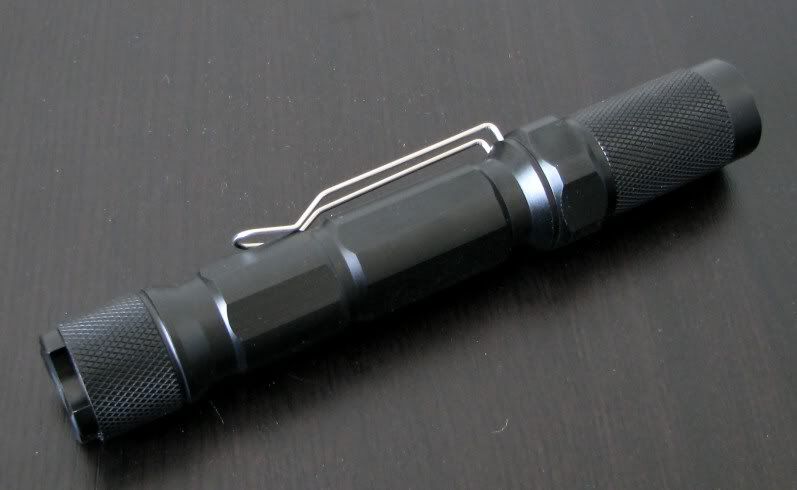
Fit and finish on the 2AA tube was excellent on my sample. Screw threads were a perfect fit - it mated beautifully with both of the LF3XT heads I have in my possession. :twothumbs:
There is very little knurling on the new body tube - it seems to rely on larger design elements to improve grip (i.e. hexagonal body flats, the larger clip, etc). These certainly seem to work well for me - no concerns about accidentally dropping it here.
So how does it compare to other dedicated 2AA lights?
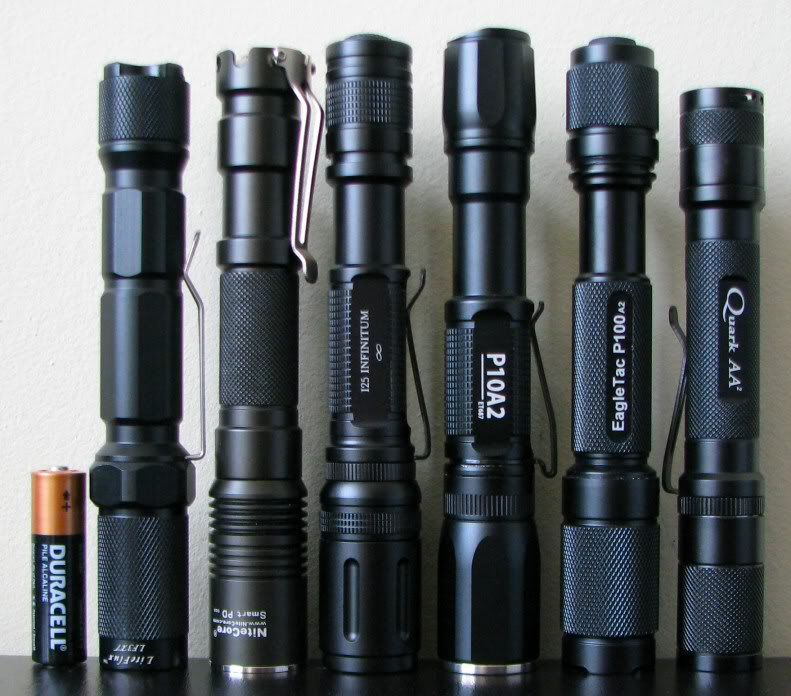
(from left to right: Duracell alkaline AA, LF3XT-2AA, NiteCore D20, Olight I-25, Eagletac P10A2, P100A2, 4Sevens Quark AA-2)
LF3XT in 2xAA Format:
Weight: 114.8g
Length x Width: 150.5mm x 25.0mm (max width)
As you can see, overall dimensions are reasonable for a 2xAA light. Although you can get smaller ones (e.g. Quark AA-2, Fenix LD20, etc), the LF3XT-2AA is certainly no more bulky than the NiteCore D20 (which is probably its closest design comparable).
Here how the emitter looks (from my original LF3XT review):
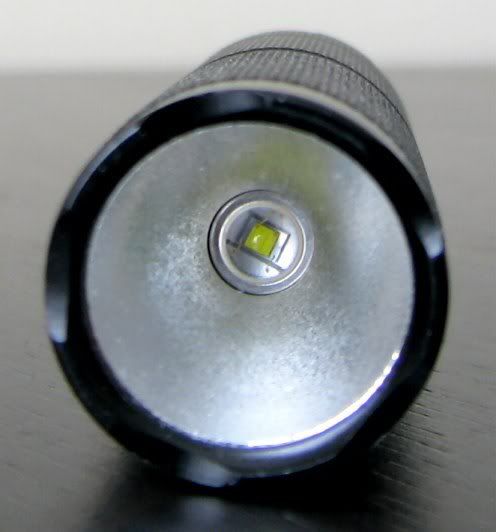
My original LF3XT uses the common Cree Q5 XR-E emitter, since R2s were hard to get in volume at the time. I believe a few batches of R2-equipped LF3XTs were sold, but I am not sure what is currently shipping with the light.
Note that the reflector is deeper than most lights, and is very finely textured - to the point where it appears like a fine haze over the reflector surface. Fairly unique to LiteFlux, this appearance actually reminds me a bit of my DIY sputtering jobs (although far more consistently applied here, of course). Scroll down for beamshots.
Note also that the build of this light is different from most. Since it uses a MCU in the head, a separate current path needs to be provided for the modes to work (in this case, a brass sleeve that the battery sits inside, which connects the tailcap switch to the retaining ring in the head). I'm too lazy to take new pics in 2xAA format, so here are a few shots from my original LF3XT review:
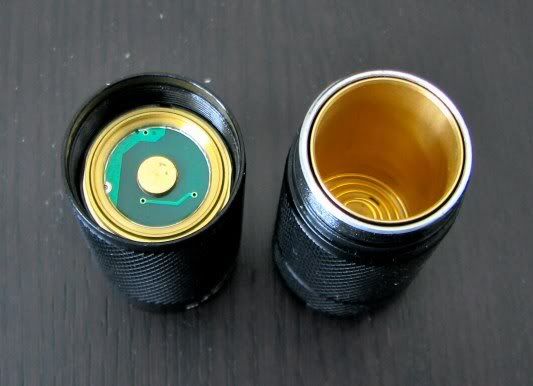
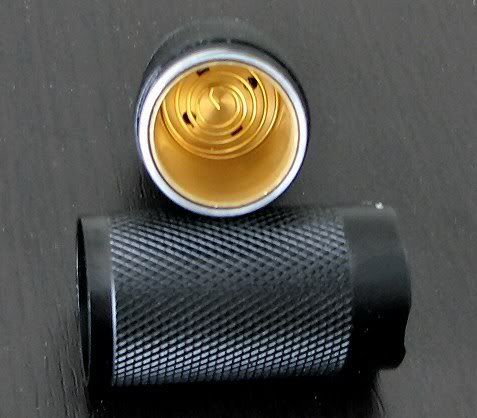
Although it may look similar to the NiteCore "Piston Drive", the LF3XT still uses an actual tailcap switch underneath the battery sleeve. But the switch is not your typical clicky - it is more like those found on modern electronic devices. A good way to describe it is like the on/off button on your LCD monitor, as compared to the traditional clicky switches found on old CRTs. Tactile feedback can be variable, and you may find yours to be a bit "soft" compared to other lights. :shrug:
The screw threads remain anodized on the body tube, so lock-out is still possible in 2xAA format. :thumbsup:
Comparison Beamshots
All lights are on 2x Sanyo Eneloop NiMH on Max. Distance is about 0.5 meters from a white wall.
1/25sec, f3.2
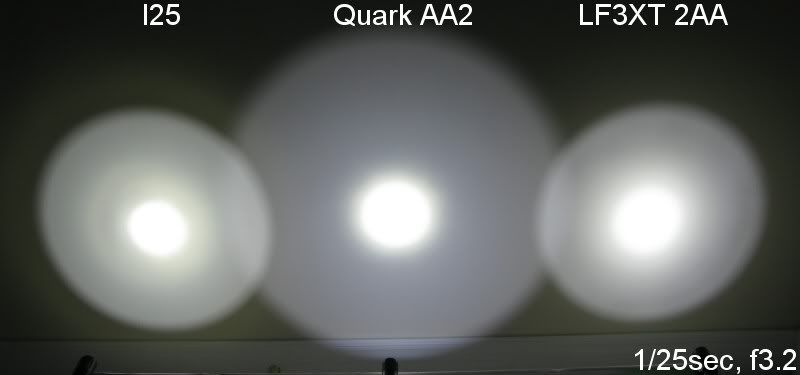
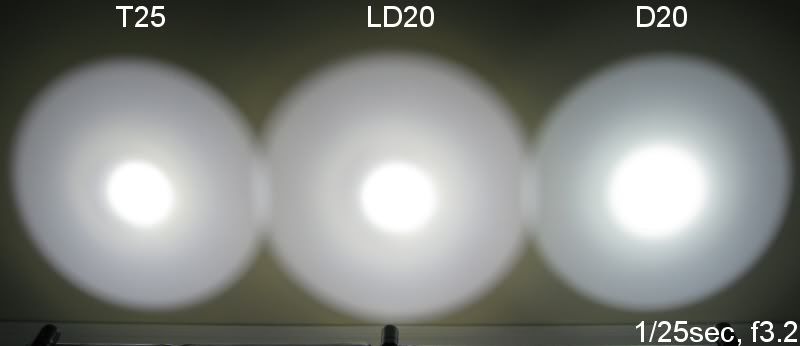
1/100sec, f3.2
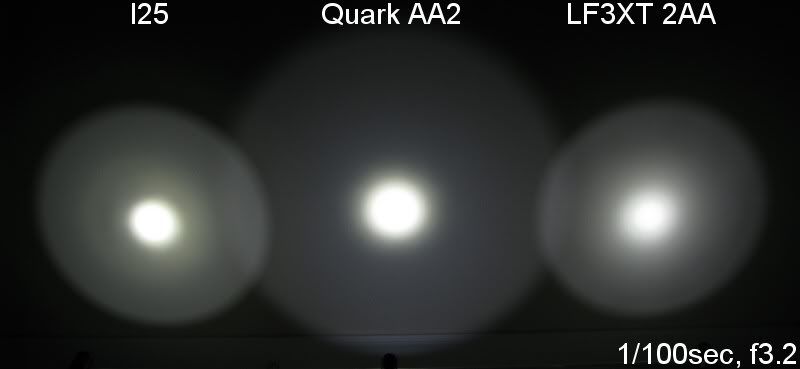
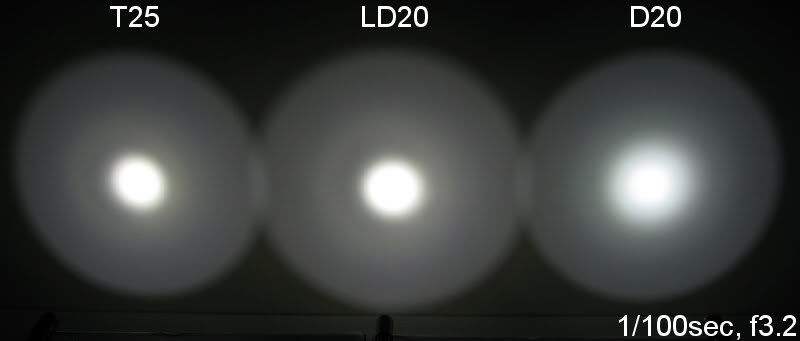
1/800sec, f3.2
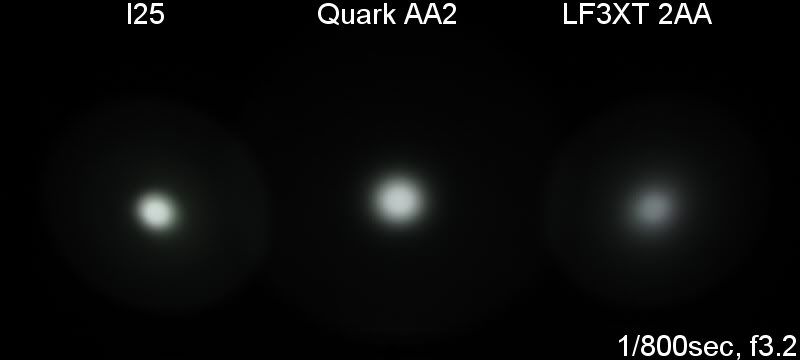
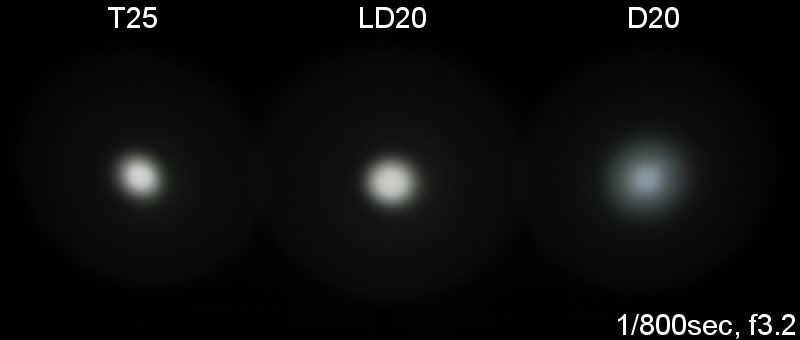
As you can see, the beam profile is very distinctive on the LF3XT - you have a much narrower (but brighter) spillbeam than most lights, thanks to the deeper reflector. Cree rings are also greatly reduced, and the hotspot is a little broader than most lights. Frankly, I find this profile to be a lot more SSC-like than Cree-like.
Tint on my sample is quite warm for a "cool white" tint, which I personally like. Note that I had specifically asked LED Cool to select a relatively warm "cool tint" – there is no guarantee what you will receive. For those of you not familiar with tint bins, please see my Colour tint comparison and the summary LED tint charts found here.
User Interface
The LF3XT was a remarkably versatile light, with a dual user-selectable interface that should please KISS-fans as well those wanting a fully user-customizable light. :kiss: Nothing has changed with the 2xAA version, since it is the same circuit/head being used.
Compact User Interface (CUI)
In Compact User Interface (CUI), the light is remarkably similar to the Nitecore D20 - but with a few differences. The D20 interface is pretty simple - with the head fully tightened, click for on/off. When on, press and hold to begin the ramp, release to select the desired level. Shortcuts to min (double-click) and max (click-press/hold) are included.
The main difference is that on the D20, your custom-set level is erased when you use the shortcuts (i.e. jump to min, and min is now your new custom-set level). With the LF3XT head, the user-selected output is retained even when shortcuts are used. The shortcuts are thus actually a toggle - e.g. double-click for min, double-click again and you are back to your pre-selected user level. :thumbsup:
This is actually very useful, except it also means that every time you turn the light on it comes back to the user defined level (i.e. if you use the shortcut to min or max and turn off the light, it will still come back on at the pre-defined level). So in the end, it all comes down to how you like to use your light - I personally like the LF3XT interface.
Full-Function User Interface (FUI)
The FUI is much more complex than the compact UI. Although the light is easy to use in practice once programmed, you will need to refer to the manual when you want to re-program any features. Please refer to LED Cool's LF3XT thread on CPFMP or the LF3XT discussion thread here on CPF for more info on how to use it. There's also a revised english manual maintained by matrishaman here, and a programming flowchart that Budman231 created (for those more visually-inclined).
Over-Discharge Protection (ODP)
One interesting feature that I will mention is the low voltage over-discharge protection (ODP) system. Although originally conceived for Li-ion based lights using batteries without protection circuits, this is actually a very useful feature for NiMH, as it prevents you from over-discharging your cells. Over-draining NiMH is potentially permanently damaging to the cells (especially low-self-discharge Eneloops).
Unlike the newer circuit on LF2XT where the various battery forms of ODP are combined into one control (and easily accessible from either interface), on the LF3XT you need to specifically set the ODP for NiMH (i.e. each battery type has its own ODP control setting). Scroll down to the runtimes to see how the ODP works in practice.
Momentary On
You can also re-program your LF3XT to act as a momentary-on instead of click-on (like you can do on the D20 by unscrewing the head slightly), but I find this less useful for either interface.
PWM
The LF3XT circuit uses pulse-width-modulation (PWM) for its low modes, measured at a frequency of 7.8 kHz in my setup. This is consistent with Manufacturer specs, and sufficiently high as to be completely undetectable by eye. :thumbsup:
For more information on the original 1xCR123A/RCR LF3XT, please see my original review here.
Testing Method: All my output numbers are relative for my home-made light box setup, a la Quickbeam's flashlightreviews.com method. You can directly compare all my relative output values from different reviews - i.e. an output value of "10" in one graph is the same as "10" in another. All runtimes are done under a cooling fan, except for the extended run Lo/Min modes which are done without cooling.
Throw values are the square-root of lux measurements taken at 1 meter from the lens, using a light meter.
Throw/Output Summary Chart:
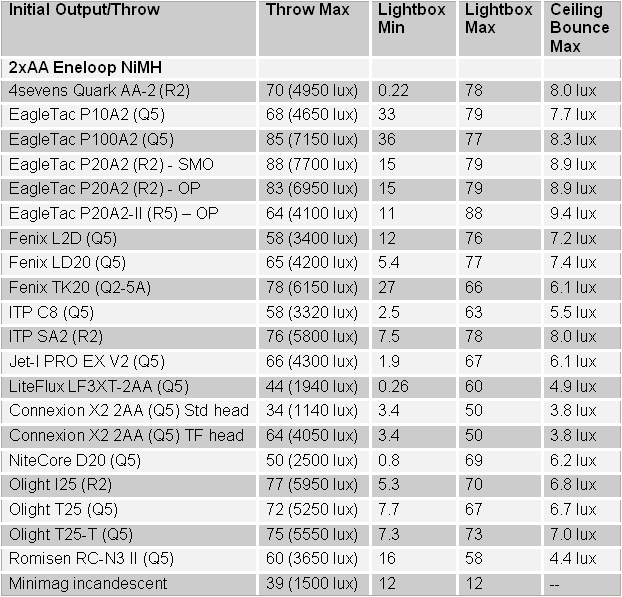
The original LF3XT's max throw and output was about typical on 1xRCR, and toward the lower end on 1xCR123A, compared to other lights of that class. In 2xAA format, max output on 2xNiMH is virtually identical to 1xCR123A, which is again toward the lower end of lights in this 2xAA class. Certainly very respectable, but don't expect a barn burner. :tinfoil:
Note that the Min output is particularly impressive – it has one of the lowest output levels of any 2AA, close to the Quark 2AA's Moonlight mode. :thumbsup:
Variable Output Ramping
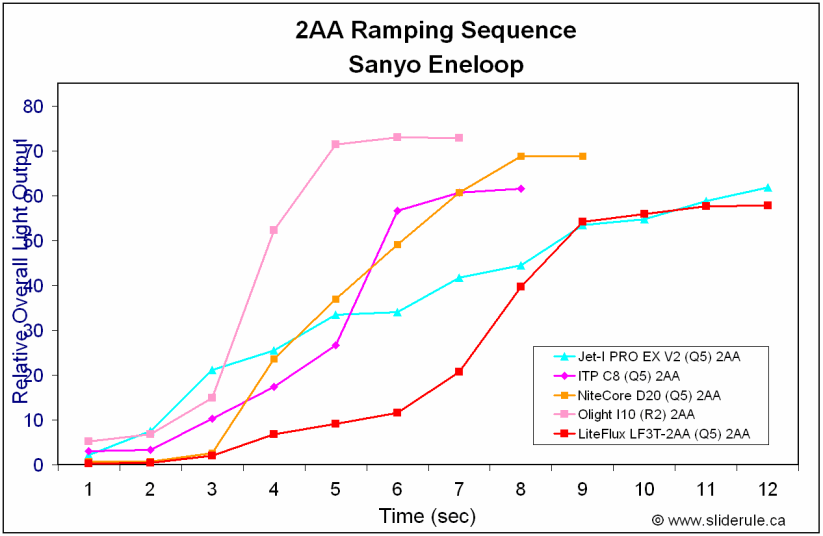
The LF3XT has two ways to adjust brightness through the FUI - step-wise "logarithmically" (which is actually visually-linear) or "linearly" (which will take you in much slower steps).
In 1xCR123A/RCR format, the CUI produces a visually-linear ramp upon press-and-hold that is much faster than the FUI manual stepping (see my LF3XT review for a trace). On 2xAA, ramping time is unchanged at ~8secs, but it doesn't seem to be quite as visually-linear.
Output/Runtime Comparison:
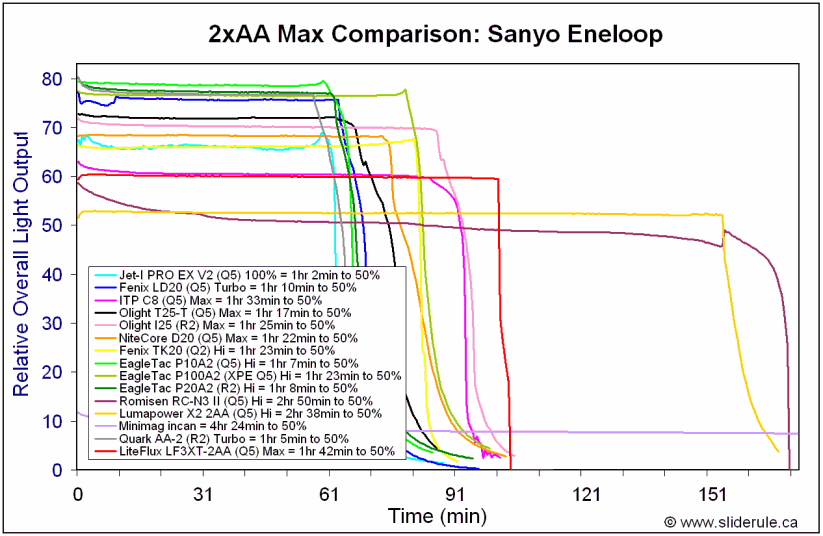
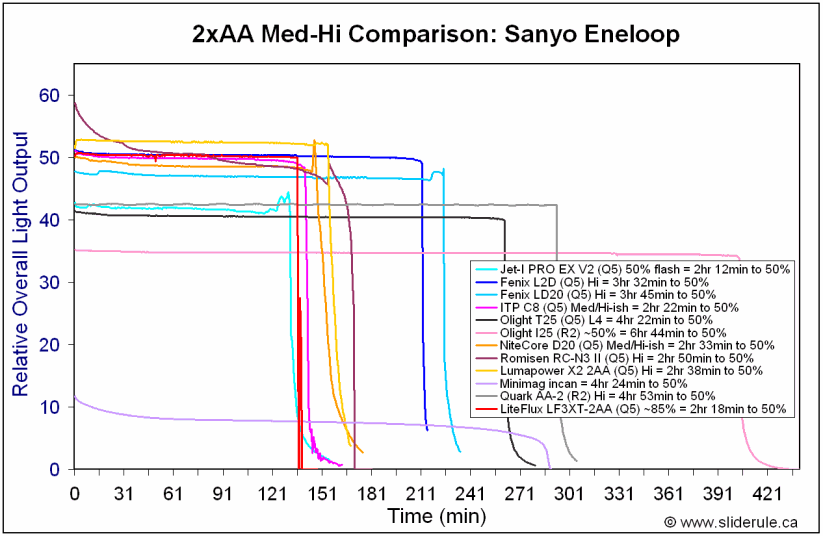
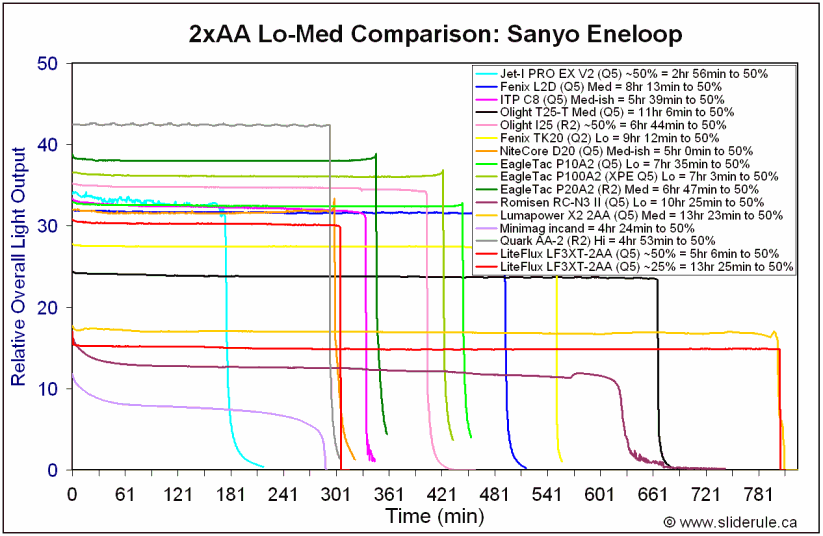
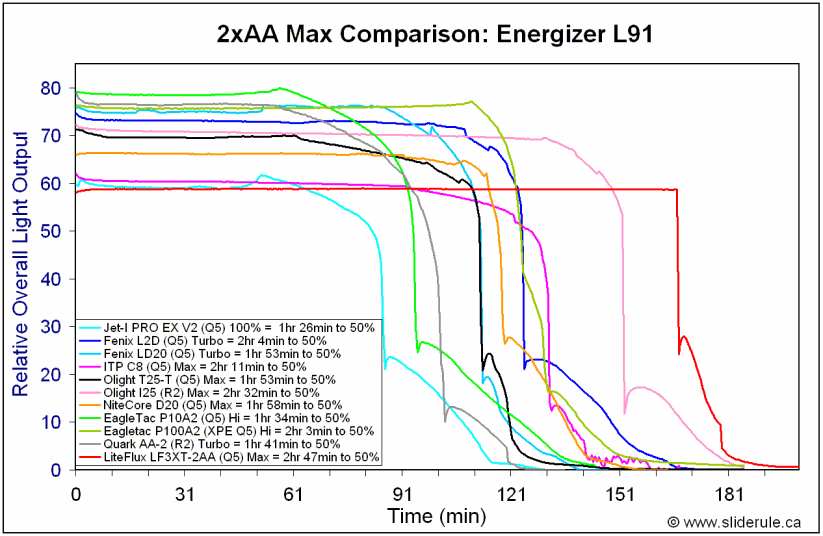
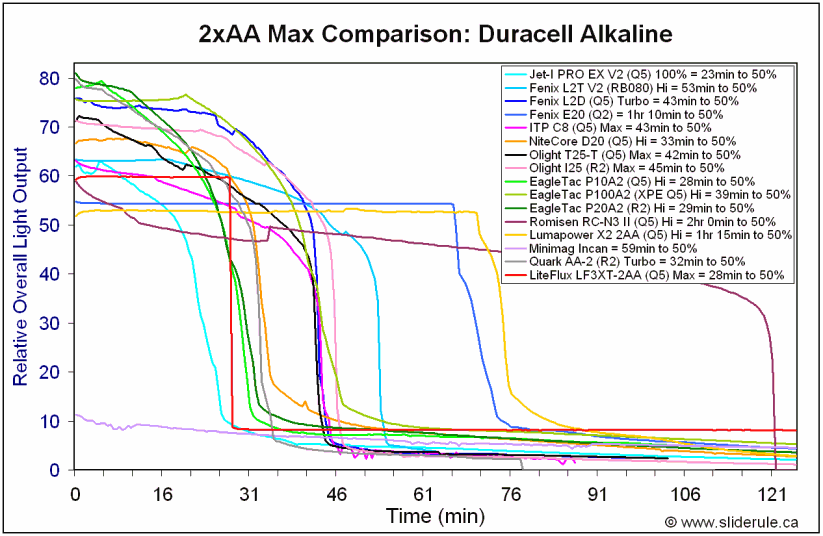
Output/Runtime Comments:
The LF3XT's circuit is very well regulated on all 2xAA battery sources, including NiMH, L91 lithium or standard alkaline batteries. oo: It's true that max output is not as high as some of the other dedicated 2xAA lights, but the regulation pattern (and battery versatility) of the LF3XT may make up for that for some users.
oo: It's true that max output is not as high as some of the other dedicated 2xAA lights, but the regulation pattern (and battery versatility) of the LF3XT may make up for that for some users.
For the Sanyo Eneloop (NiMH) runs above, the over-discharge protection circuit was turned on. As you can see, the light cut-out shortly after falling out of regulation (likely ~1V). :thumbsup:
There is an interesting pattern on standard alkalines on Max: the light runs regulated as long as it can, and then instantly drops to a lower (regulated) output level when it can no longer sustain the higher current draw. This is unlike most other 2xAA lights, which simply run in a direct drive pattern on alkaline.
UPDATE AUGUST 12, 2009: Here is how the 2xAA version compares in output/runtime to the 1xCR123A/RCR version:
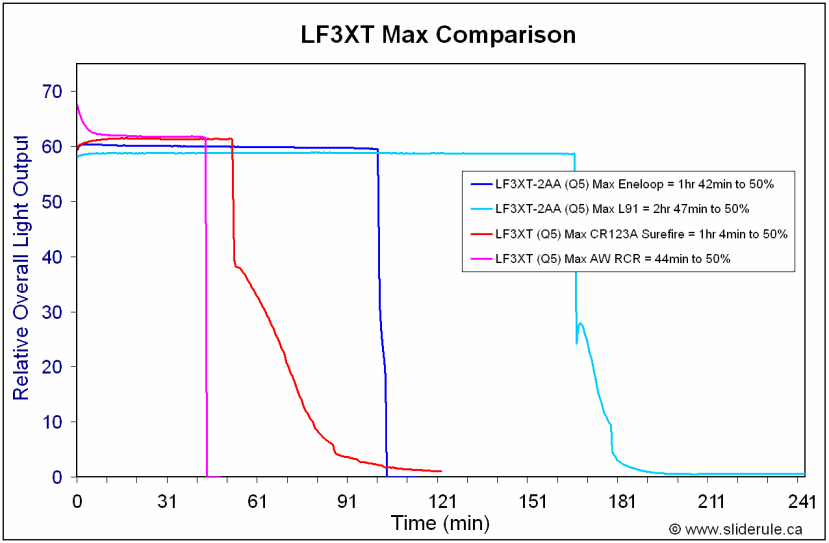
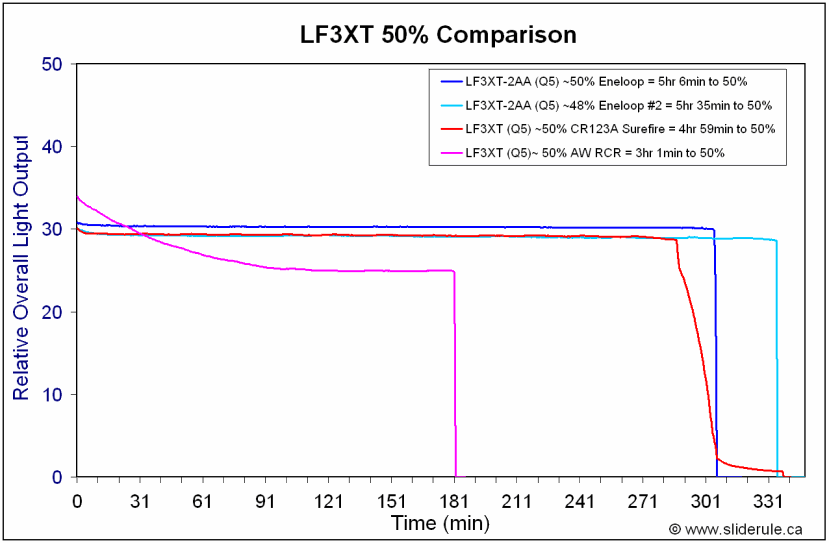
As you can see, the 2xAA format - even on regular Eneloops - offers a significant advantage on runtime over 1xCR123A/RCR, when run on Max. This advantage is reduced at lower drive currents, when compared to CR123A. However, I haven't done L91 lithium runs at 50% output - I would expect a considerable advantage to 2xL91 over 1xCR123A.
Potential Issues
The replacement tailcap with removable clip is a nice upgrade feature, but I personally find this clip to be a bit on the thin side. You may need to fiddle with the clip a bit to get the tailcap to fully screw down. There may also be some variance with the early batch LF3XTs, making it difficult to screw down this new tailcap all the way even with the clip fix (i.e. I needed to use vicegrips and a cloth on one LF3XT to fully tighten, but could do it easily by hand on the 2AA body tube).
Overall spillbeam width is narrower than most 2xAA lights, and with less throw than most.
Performance on 2xAA is generally good, but max output is not quite as high as many of the dedicated 2xAA lights (and throw is typically lower than most).
Runtime pattern on 2xAA alkalines is not likely to be optimal for most users (i.e. fully regulated outputs only).
As mentioned in my LF3XT review, the ~0.3 sec lag in responding to some button presses takes a little getting used to. The button also has a much shorter traverse, in keeping with an electronic switch as opposed to a traditional clicky (there is a greater discussion of the button feel issue in my LF3XT review). Not really problems per se, just a different set of features.
General Observations
Readers of my reviews will probably know that I am a fan of the LF3XT. It has been my EDC for several months now, and I am very happy with its performance. The new tailcap with removable clip a nice upgrade, but I am more interested in the new 2AA body tube/clip (2xAA support had always been present in the original circuit). I am thus glad to see the 2xAA tube is finally out, as it increases the versatility of this light (and gives the option for extended runtime on standard cells).
The design of the 2AA battery tube is certainly very workman-like. It has a very substantial feel, quite solid and sturdy, and it mated well with my LF3XT heads. Although it may seem a bit bulky compared to the slim-lined competition, it is certainly well within the standard range for high-end 2xAA lights. Knurling is limited and not very aggressive, but the hexagonal body flats and clip help with grip.
Performance on NiMH is certainly quite acceptable, well in keeping with other continuously-variable lights. Max output may not be quite as high as some of the competition, but the battery flexibility and circuit features/control of this design are major pluses in my books. The low-voltage ODP feature is a particularly nice bonus, as you don't have to worry about accidentally over-discharging (and potentially damaging) your NiMH cells this way. :thumbsup: I wish more AA-style lights would offer this feature!
I don't generally recommend running modern LED lights on standard alkalines (mainly for their potential to leak and damage the light, but also for their lower power supply capabilities). But if you do want to run alkalines, I suspect this likely isn't the 2xAA light for you – the fully regulated pattern means the light will fairly quickly step-down to a low output, rather than gradually drop-off. :shrug: Of course, some people may actually like that pattern – but personally, I'll stick with L91 or NiMH.
The LF3XT beam remains very nice, with one of the smoothest transitions from spot to spill I've seen in a Cree light. But note that the spillbeam width is quite narrow (similar to the Olight T25 an I25 lights), which may not suit everyone in a 2xAA light. Throw is also lower than most lights in this class.
But note that the spillbeam width is quite narrow (similar to the Olight T25 an I25 lights), which may not suit everyone in a 2xAA light. Throw is also lower than most lights in this class.
Simply put, all the features of the original LF3XT are retained in this 2AA build – with the added flexibility of running on standard 2xAA. :kiss: The versatility of this light is hard to beat. It certainly provides another valuable option in the 2xAA realm.
Warning: Pic heavy!

Original LF3XT Manufacturer's Specifications
- LED : CREE XR-E Q5 bin
- Approximate LED current at 100% output level : 700ma when using CR123
- Input voltage : 2.0V - 4.5V (CR123/16340)
- Battery chemistry allowed : Primary Lithium CR123(3.0V), rechargeable Li-Ion 16340(4.2V) & rechargeable LiFePO4.
- PWM Frequency 7800Hz.
- Material = 6061 T6 Aluminium Alloy.
- Tail press button machined from 6061 T6 Aluminium Alloy with shinny finish.
- AR Coated glass lens.
- Finishing : available in 1 colour - BLACK HA III.
- O ring seal at lens, battery tube and tack switch.
- Split ring hole at tail end. Stable tail stand.
- All parts can be disassembled for cleaning and maintenance.
- Water resistant for daily normal use. NOT suitable for diving or swimming.
- Size: 80mm length. 23mm diameter.
- Standard Accessories: Lanyard, 2pcs spare O rings, A small container of silicon lubricant for the o-rings, Instruction manual
- Features a removable clip
- Adds 4 holes on the cross-hatch retaining ring
- Smoothed-over vertical edges on cross-hatch retaining ring
- Includes an acrylic tool/stand for help in removing the tailcap
- Note this tailcap with add 1.5mm to the overall length of your LF3XT.
- In conjunction with LF3XT Head, provides support for 2xAA (NiMH, standard alkaline, or L91 lithium)
- Features its own tailcap and a removable long pocket clip (bezel-up orientation).
- Do NOT attempt 2x14500, or you will destroy the circuit.
Please see my original LF3XT review for a thorough background on this light.
New Tailcap with Built-in Clip

The new tailcap is designed with space to include a pocket clip (under a lip near the opening). This makes it ~1.5mm taller than the original tailcap. It also features rounded vertical edges on the cross-headed retaining ring, and a hole in each of the four corners (the original tailcap had only a single hole). The hole can be used to attach a clip-ring, or to help with unscrewing by inserting a suitably stiff rod of proper dimension and twisting the ring counter-clockwise.
To facilitate exchange of the tailcap, the replacement version also comes with an acrylic base that perfectly fits the cross-headed ring, allowing easy unscrewing.
Here's what the original LF3XT looks like when you get it open:

When I first tried to install this new tailcap/clip on one of my LF3XTs, I encountered a slight problem - the pressure of the body on the end of the clip was slightly forcing the end of the clip ring out of the tailcap while tightening. The best I could get it was as follows:

As you can see, the clip ring is preventing the tailcap from fully screwing down. The light cannot function this way, as it is preventing contact between the tailcap and the battery tube.

I found I needed to slightly bend out the clip to prevent this from occurring during tightening:

As you can see, I've bent the clip more than was necessary to get it on (shown using the 2AA body above). I advise caution when playing with the tolerances here - try installing the clip as shipped. If you have any problems, apply no more than a slight pressure to bending out the clip. You don't want to do any more than is necessary to get it on.

FYI, even once I had resolved the clip issue, I still had difficulty tightening the new button/clip sufficiently to allow activation on my LF3XT body. Even with the tailcap tool, I found I needed to use vicegrips on the body to fully tighten (with a cloth to prevent marring the finish, of course) . It was much easier to tighten the new tailcap onto the 2AA body (could be done by hand easily with the tool), so it's possible there is some variance involved with first batch LF3XTs. :shrug:

(from left to right: AW protected RCR, LF3XT with new clip tailcap, LF3XT with 2xAA battery tube and tailcap)
2xAA Battery Tube


Fit and finish on the 2AA tube was excellent on my sample. Screw threads were a perfect fit - it mated beautifully with both of the LF3XT heads I have in my possession. :twothumbs:
There is very little knurling on the new body tube - it seems to rely on larger design elements to improve grip (i.e. hexagonal body flats, the larger clip, etc). These certainly seem to work well for me - no concerns about accidentally dropping it here.
So how does it compare to other dedicated 2AA lights?

(from left to right: Duracell alkaline AA, LF3XT-2AA, NiteCore D20, Olight I-25, Eagletac P10A2, P100A2, 4Sevens Quark AA-2)
LF3XT in 2xAA Format:
Weight: 114.8g
Length x Width: 150.5mm x 25.0mm (max width)
As you can see, overall dimensions are reasonable for a 2xAA light. Although you can get smaller ones (e.g. Quark AA-2, Fenix LD20, etc), the LF3XT-2AA is certainly no more bulky than the NiteCore D20 (which is probably its closest design comparable).
Here how the emitter looks (from my original LF3XT review):

My original LF3XT uses the common Cree Q5 XR-E emitter, since R2s were hard to get in volume at the time. I believe a few batches of R2-equipped LF3XTs were sold, but I am not sure what is currently shipping with the light.
Note that the reflector is deeper than most lights, and is very finely textured - to the point where it appears like a fine haze over the reflector surface. Fairly unique to LiteFlux, this appearance actually reminds me a bit of my DIY sputtering jobs (although far more consistently applied here, of course). Scroll down for beamshots.
Note also that the build of this light is different from most. Since it uses a MCU in the head, a separate current path needs to be provided for the modes to work (in this case, a brass sleeve that the battery sits inside, which connects the tailcap switch to the retaining ring in the head). I'm too lazy to take new pics in 2xAA format, so here are a few shots from my original LF3XT review:


Although it may look similar to the NiteCore "Piston Drive", the LF3XT still uses an actual tailcap switch underneath the battery sleeve. But the switch is not your typical clicky - it is more like those found on modern electronic devices. A good way to describe it is like the on/off button on your LCD monitor, as compared to the traditional clicky switches found on old CRTs. Tactile feedback can be variable, and you may find yours to be a bit "soft" compared to other lights. :shrug:
The screw threads remain anodized on the body tube, so lock-out is still possible in 2xAA format. :thumbsup:
Comparison Beamshots
All lights are on 2x Sanyo Eneloop NiMH on Max. Distance is about 0.5 meters from a white wall.
1/25sec, f3.2


1/100sec, f3.2


1/800sec, f3.2


As you can see, the beam profile is very distinctive on the LF3XT - you have a much narrower (but brighter) spillbeam than most lights, thanks to the deeper reflector. Cree rings are also greatly reduced, and the hotspot is a little broader than most lights. Frankly, I find this profile to be a lot more SSC-like than Cree-like.
Tint on my sample is quite warm for a "cool white" tint, which I personally like. Note that I had specifically asked LED Cool to select a relatively warm "cool tint" – there is no guarantee what you will receive. For those of you not familiar with tint bins, please see my Colour tint comparison and the summary LED tint charts found here.
User Interface
The LF3XT was a remarkably versatile light, with a dual user-selectable interface that should please KISS-fans as well those wanting a fully user-customizable light. :kiss: Nothing has changed with the 2xAA version, since it is the same circuit/head being used.
Compact User Interface (CUI)
In Compact User Interface (CUI), the light is remarkably similar to the Nitecore D20 - but with a few differences. The D20 interface is pretty simple - with the head fully tightened, click for on/off. When on, press and hold to begin the ramp, release to select the desired level. Shortcuts to min (double-click) and max (click-press/hold) are included.
The main difference is that on the D20, your custom-set level is erased when you use the shortcuts (i.e. jump to min, and min is now your new custom-set level). With the LF3XT head, the user-selected output is retained even when shortcuts are used. The shortcuts are thus actually a toggle - e.g. double-click for min, double-click again and you are back to your pre-selected user level. :thumbsup:
This is actually very useful, except it also means that every time you turn the light on it comes back to the user defined level (i.e. if you use the shortcut to min or max and turn off the light, it will still come back on at the pre-defined level). So in the end, it all comes down to how you like to use your light - I personally like the LF3XT interface.
Full-Function User Interface (FUI)
The FUI is much more complex than the compact UI. Although the light is easy to use in practice once programmed, you will need to refer to the manual when you want to re-program any features. Please refer to LED Cool's LF3XT thread on CPFMP or the LF3XT discussion thread here on CPF for more info on how to use it. There's also a revised english manual maintained by matrishaman here, and a programming flowchart that Budman231 created (for those more visually-inclined).
Over-Discharge Protection (ODP)
One interesting feature that I will mention is the low voltage over-discharge protection (ODP) system. Although originally conceived for Li-ion based lights using batteries without protection circuits, this is actually a very useful feature for NiMH, as it prevents you from over-discharging your cells. Over-draining NiMH is potentially permanently damaging to the cells (especially low-self-discharge Eneloops).
Unlike the newer circuit on LF2XT where the various battery forms of ODP are combined into one control (and easily accessible from either interface), on the LF3XT you need to specifically set the ODP for NiMH (i.e. each battery type has its own ODP control setting). Scroll down to the runtimes to see how the ODP works in practice.
Momentary On
You can also re-program your LF3XT to act as a momentary-on instead of click-on (like you can do on the D20 by unscrewing the head slightly), but I find this less useful for either interface.
PWM
The LF3XT circuit uses pulse-width-modulation (PWM) for its low modes, measured at a frequency of 7.8 kHz in my setup. This is consistent with Manufacturer specs, and sufficiently high as to be completely undetectable by eye. :thumbsup:
For more information on the original 1xCR123A/RCR LF3XT, please see my original review here.
Testing Method: All my output numbers are relative for my home-made light box setup, a la Quickbeam's flashlightreviews.com method. You can directly compare all my relative output values from different reviews - i.e. an output value of "10" in one graph is the same as "10" in another. All runtimes are done under a cooling fan, except for the extended run Lo/Min modes which are done without cooling.
Throw values are the square-root of lux measurements taken at 1 meter from the lens, using a light meter.
Throw/Output Summary Chart:

The original LF3XT's max throw and output was about typical on 1xRCR, and toward the lower end on 1xCR123A, compared to other lights of that class. In 2xAA format, max output on 2xNiMH is virtually identical to 1xCR123A, which is again toward the lower end of lights in this 2xAA class. Certainly very respectable, but don't expect a barn burner. :tinfoil:
Note that the Min output is particularly impressive – it has one of the lowest output levels of any 2AA, close to the Quark 2AA's Moonlight mode. :thumbsup:
Variable Output Ramping

The LF3XT has two ways to adjust brightness through the FUI - step-wise "logarithmically" (which is actually visually-linear) or "linearly" (which will take you in much slower steps).
In 1xCR123A/RCR format, the CUI produces a visually-linear ramp upon press-and-hold that is much faster than the FUI manual stepping (see my LF3XT review for a trace). On 2xAA, ramping time is unchanged at ~8secs, but it doesn't seem to be quite as visually-linear.
Output/Runtime Comparison:





Output/Runtime Comments:
The LF3XT's circuit is very well regulated on all 2xAA battery sources, including NiMH, L91 lithium or standard alkaline batteries.
For the Sanyo Eneloop (NiMH) runs above, the over-discharge protection circuit was turned on. As you can see, the light cut-out shortly after falling out of regulation (likely ~1V). :thumbsup:
There is an interesting pattern on standard alkalines on Max: the light runs regulated as long as it can, and then instantly drops to a lower (regulated) output level when it can no longer sustain the higher current draw. This is unlike most other 2xAA lights, which simply run in a direct drive pattern on alkaline.
UPDATE AUGUST 12, 2009: Here is how the 2xAA version compares in output/runtime to the 1xCR123A/RCR version:


As you can see, the 2xAA format - even on regular Eneloops - offers a significant advantage on runtime over 1xCR123A/RCR, when run on Max. This advantage is reduced at lower drive currents, when compared to CR123A. However, I haven't done L91 lithium runs at 50% output - I would expect a considerable advantage to 2xL91 over 1xCR123A.
Potential Issues
The replacement tailcap with removable clip is a nice upgrade feature, but I personally find this clip to be a bit on the thin side. You may need to fiddle with the clip a bit to get the tailcap to fully screw down. There may also be some variance with the early batch LF3XTs, making it difficult to screw down this new tailcap all the way even with the clip fix (i.e. I needed to use vicegrips and a cloth on one LF3XT to fully tighten, but could do it easily by hand on the 2AA body tube).
Overall spillbeam width is narrower than most 2xAA lights, and with less throw than most.
Performance on 2xAA is generally good, but max output is not quite as high as many of the dedicated 2xAA lights (and throw is typically lower than most).
Runtime pattern on 2xAA alkalines is not likely to be optimal for most users (i.e. fully regulated outputs only).
As mentioned in my LF3XT review, the ~0.3 sec lag in responding to some button presses takes a little getting used to. The button also has a much shorter traverse, in keeping with an electronic switch as opposed to a traditional clicky (there is a greater discussion of the button feel issue in my LF3XT review). Not really problems per se, just a different set of features.
General Observations
Readers of my reviews will probably know that I am a fan of the LF3XT. It has been my EDC for several months now, and I am very happy with its performance. The new tailcap with removable clip a nice upgrade, but I am more interested in the new 2AA body tube/clip (2xAA support had always been present in the original circuit). I am thus glad to see the 2xAA tube is finally out, as it increases the versatility of this light (and gives the option for extended runtime on standard cells).
The design of the 2AA battery tube is certainly very workman-like. It has a very substantial feel, quite solid and sturdy, and it mated well with my LF3XT heads. Although it may seem a bit bulky compared to the slim-lined competition, it is certainly well within the standard range for high-end 2xAA lights. Knurling is limited and not very aggressive, but the hexagonal body flats and clip help with grip.
Performance on NiMH is certainly quite acceptable, well in keeping with other continuously-variable lights. Max output may not be quite as high as some of the competition, but the battery flexibility and circuit features/control of this design are major pluses in my books. The low-voltage ODP feature is a particularly nice bonus, as you don't have to worry about accidentally over-discharging (and potentially damaging) your NiMH cells this way. :thumbsup: I wish more AA-style lights would offer this feature!
I don't generally recommend running modern LED lights on standard alkalines (mainly for their potential to leak and damage the light, but also for their lower power supply capabilities). But if you do want to run alkalines, I suspect this likely isn't the 2xAA light for you – the fully regulated pattern means the light will fairly quickly step-down to a low output, rather than gradually drop-off. :shrug: Of course, some people may actually like that pattern – but personally, I'll stick with L91 or NiMH.
The LF3XT beam remains very nice, with one of the smoothest transitions from spot to spill I've seen in a Cree light.
Simply put, all the features of the original LF3XT are retained in this 2AA build – with the added flexibility of running on standard 2xAA. :kiss: The versatility of this light is hard to beat. It certainly provides another valuable option in the 2xAA realm.
Last edited:


